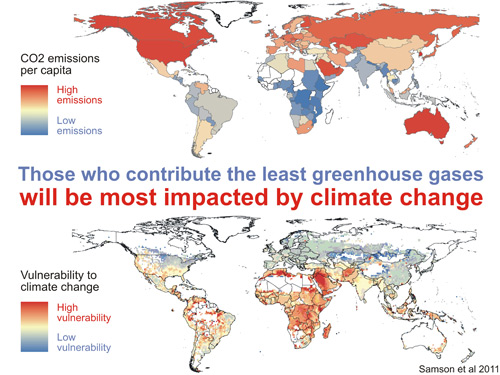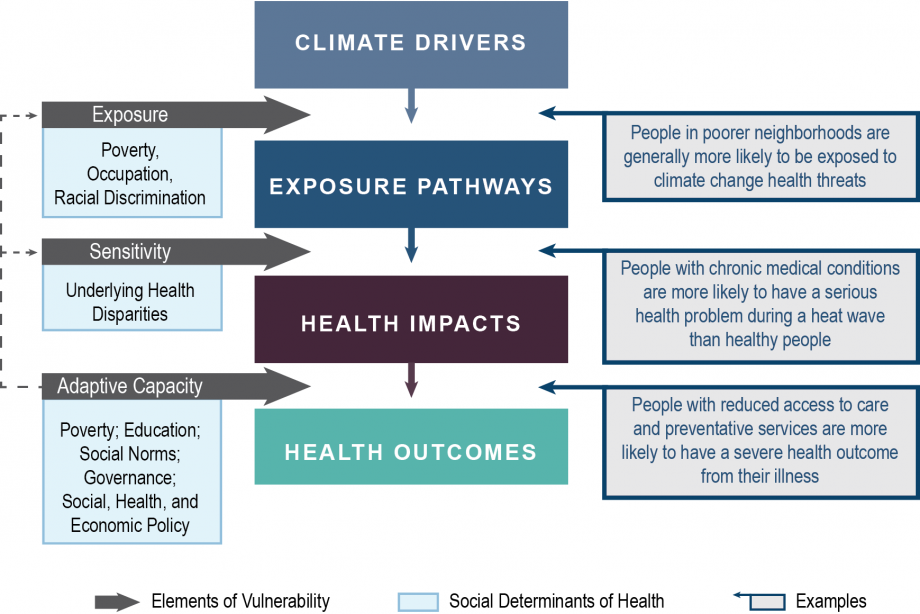We've looked at the components of vulnerability (exposure, sensitivity, and adaptive capacity). But, let's try to dig in a bit deeper to find out what influences each of those components. Understanding who is most vulnerable to impacts is pivotal in creating successful adaptation and resiliency plans. The Thomas et al. reading for this week takes a much deeper, more comprehensive dive into the myriad factors associated with vulnerability, but before we jump into that, let's focus on some of the highlights.
The definitions in quotes below come from the IPCC TAR WGII (2001):
- exposure - "contact between a person and one or more biological, psychosocial, chemical, or physical stressors, including stressors affected by climate change"
- While developing places like coastal Bangladesh are certainly more exposed to some impacts of climate change, particularly related to extreme weather, exposure alone doesn't tell the whole story as to how socioeconomic status might increase one's vulnerability. Exposure played a bigger role in the vulnerability of victims of Hurricane Katrina, though. Residents of places like the Lower Ninth Ward, a working-class neighborhood, were living below sea level near inadequate levies. This isn't always the case though, sometimes our most exposed housing stock is also the most luxurious, as we see when hurricanes graze the eastern US and threaten extravagant vacation homes.
- While developing places like coastal Bangladesh are certainly more exposed to some impacts of climate change, particularly related to extreme weather, exposure alone doesn't tell the whole story as to how socioeconomic status might increase one's vulnerability. Exposure played a bigger role in the vulnerability of victims of Hurricane Katrina, though. Residents of places like the Lower Ninth Ward, a working-class neighborhood, were living below sea level near inadequate levies. This isn't always the case though, sometimes our most exposed housing stock is also the most luxurious, as we see when hurricanes graze the eastern US and threaten extravagant vacation homes.
- sensitivity - "the degree to which a system is affected, either adversely or beneficially, by climate-related stimuli"
- Thinking about those big beach houses is a good segue into the role of sensitivity in determining your vulnerability to climate change and how your socio-economic status affects that. Imagine two storms with similar destruction. One storm strikes the Lower Ninth Ward, the other strikes the Outer Banks in North Carolina. Which homes are more likely to be insured? Which homeowners are more likely to have the resources to rebuild? So, even when we imagine situations with the same type of climate change impact occurring, depending on your socioeconomic status, even if exposure is equal, sensitivity is not.
- Thinking about those big beach houses is a good segue into the role of sensitivity in determining your vulnerability to climate change and how your socio-economic status affects that. Imagine two storms with similar destruction. One storm strikes the Lower Ninth Ward, the other strikes the Outer Banks in North Carolina. Which homes are more likely to be insured? Which homeowners are more likely to have the resources to rebuild? So, even when we imagine situations with the same type of climate change impact occurring, depending on your socioeconomic status, even if exposure is equal, sensitivity is not.
- adaptive capacity - "the ability of a system to adjust to climate change (including climate variability and extremes) to moderate potential damages, to take advantage of opportunities, or to cope with the consequences"
- This leads us to think about an individual or group's overall adaptive capacity in the face of climate change impacts.
Socio-economic status: Let's look at this at a few different geographic scales. In general, people who live in the least-developed countries are most vulnerable to many of the current and expected impacts of climate change. However, this is not at all to say that people living in poverty in the developed world are somehow immune to the impacts of climate change, far from it. Let's take a look at the global scale first.
It is often the case that those people who have contributed the least to causing the climate crisis stands to be the most adversely impacted by its consequences. Those of us who enjoy comfortable, carbon-intensive lives are often more insulated from the impacts.

But even within the confines of a developed country, people experience vulnerability quite differently. The flow chart below, while tailored specifically to human health outcomes, provides a useful framework for contextualizing how the various facets of vulnerability work together to determine the severity with which a person or group of people will experience an impact. As you look at the examples under each of the facets of vulnerability, be thinking about how varied these experiences will be among Americans (as an example). Does the developed world in general (and therefore the US) have a stronger adaptive capacity than other places? Absolutely. But, do certain segments of the American population have a weaker adaptive capacity than others? Also absolutely.

Flow chart starts with climate drivers leading to exposure pathways
In between them is the exposure element of vulnerability. This is poverty, occupation, and racial discrimination. For example, people in poorer neighborhoods are generally more likely to be exposed to climate change health threats.
Exposure pathways lead to health impacts
In between them is the sensitivity element of vulnerability. This is an underlying health disparity. For example, people with chronic medical conditions are more likely to have a serious health problem during a heatwave than healthy people.
Health impacts lead to health outcomes
In between them is the adaptive capacity element of vulnerability. This is poverty; education; social norms; governance; social, health, and economic policy. For example, people with reduced access to care and preventative services are more likely to have a severe health outcome from their illness
Health: The infirm, either through age (very young or very old), illness, or handicap are far more sensitive and have a lower adaptive capacity despite what could be modest exposure. In other words, an impact that might not harm a healthy person could be quite consequential for a sick one.
- The 2003 European Heat Wave is a sobering example of this. Just in Paris, France, almost 15,000 people died. Most of them were elderly women living on high floors of poorly ventilated buildings (research by Richard Keller from the University of Wisconsin-Madison, cited in Why Heat Waves Can Mean High Death Tolls, 2012). Elderly folks do not often observe early signs of dehydration and may take certain medications that exacerbate their sensitivity to extreme heat. This, coupled with the fact that many elderly people live alone and are on fixed incomes with limited mobility creates a perfect storm of vulnerability to some impacts of climate change.
Side note - Is anyone surprised to learn that in our lifetimes, in a developed country, almost 15,000 people died from heat stress during a single heatwave event? Perhaps it's just me, but I am as floored by this every time I revisit it as I was when it unfolded.
